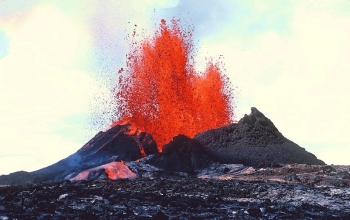|

Press Release 05-148
Study Reconciles Long-Standing Contradiction of Deep-Earth Dynamics

New databases give researchers a look into processes inside the Earth's mantle
August 25, 2005
Scientists at Columbia University's Lamont-Doherty Earth Observatory (LDEO) have solved a long-standing contradiction about the workings of the deep Earth.
While some geochemists have argued that parts of the deep mantle have remained unchanged since the formation of the Earth, some geophysicists and others have believed that the entire mantle has been moving throughout geologic time. The question of whether the deep-Earth changes is central to scientists' understanding of the process of heat loss from deep beneath the surface.
LDEO earth scientists Cornelia Class and Steven Goldstein now show that the evidence favors a moving mantle, with the deepest parts of the Earth affected by the same tectonic processes that occur at the surface. The study appears in the Aug. 25 issue of the journal Nature.
"For 30 years scientists have debated whether there is a layer of the mantle that has remained unchanged since the formation of the Earth," said Class. "We found the strongest evidence yet that indicates the opposite is true."
Class and Goldstein's re-evaluation of this concept of the inner Earth is based on their work with two new databases: the Petrological Database of Ocean Floor Basalts (PetDB) and Geochemistry of Rocks from the Oceans and Continents (GEOROC).
Scientists have known that upper mantle basalt found at mid-ocean ridges, formed by sea-floor spreading, comes from previously formed oceanic and continental crust. The new global data synthesis demonstrates that ocean island lavas, chemically most like mid-ocean ridge basalt, were previously processed by plate tectonics, say Class and Goldstein, indicating that the deep mantle has been continually moving and mixing.
This result adds to growing evidence "that most of Earth's mantle has been subject to the same forces that drive the movements of Earth's crust," said Sonia Esperanca, a program director in the National Science Foundation (NSF)'s Division of Earth Sciences, which funded the research.
-NSF-

Media Contacts
Cheryl Dybas, NSF (703) 292-7734 cdybas@nsf.gov
Ken Kostel, LDEO (212) 854-9729 kkostel@ei.columbia.edu

The National Science Foundation (NSF) is an independent federal agency that
supports fundamental research and education across all fields of science and
engineering, with an annual budget of $6.06 billion. NSF funds reach all 50
states through grants to over 1,900 universities and institutions. Each year,
NSF receives about 45,000 competitive requests for funding, and makes over
11,500 new funding awards. NSF also awards over $400 million in
professional and service contracts yearly.
 Get News Updates by Email Get News Updates by Email
Useful NSF Web Sites:
NSF Home Page: http://www.nsf.gov
NSF News: http://www.nsf.gov/news/
For the News Media: http://www.nsf.gov/news/newsroom.jsp
Science and Engineering Statistics: http://www.nsf.gov/statistics/
Awards Searches: http://www.nsf.gov/awardsearch/
| 

